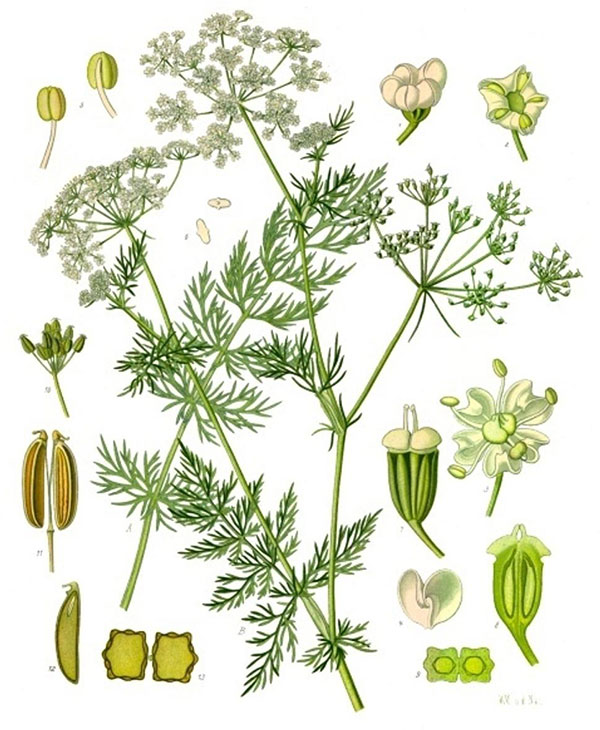Caraway

Caraway (Carum carvi)
Illustration - Köhlers Medizinal-Pflanzen (1897) (PD)

Background & General Info
Caraway is grown widely around the world as a common household plant whose fruits are used as flavoring agents in foods and beverages and as an alternative medicine. [1] It likely originated from western Turkey during the ancient times but has now spread throughout North and Central Europe and Central Asia. Caraway “seed,” which truly is a minute fruit, are added to cakes, breads, soups, and meat dishes as flavoring. [2]
Caraway - Botany
Caraway is a branched herbaceous plant that possesses bipinnate, feathery leaves having filiform to lanceolate or oval segments. Its main stem holds small white or pinkish flowers in umbels. The ovoid to oblong, light brown or yellowish brown fruits are erroneously referred to as “seeds” and are actually crescent-shaped achenes, with each half having five pale obtuse ridges. Its roots are fusiform and elongated. [2]
Caraway - History & Traditional Use
Caraway has long been cultivated in the northern and central regions of Europe, Egypt, Australia, China, and Iran as a vital medicinal plant with traditional therapeutic uses for conditions related to the gastrointestinal tract, including dyspepsia, bloating, diarrhea and flatulent colic. [1] In Moroccan traditional medicine, the ripe fruits of caraway are prescribed to increase urine flow (i.e., diuretic). [3] Avicenna, a Persian physician and writer of the Islamic Golden Age, suggested caraway for weight loss. [4] According to Ayurveda, the ancient therapeutic system of India, caraway seeds hold carminative, eupeptic, antispasmodic, and astringent properties and can be used to treat mild digestive disorders, diarrhea, dyspepsia, flatulence, morning sickness, colic, dyspeptic headache, and bloating. [5] In Poland, caraway is advised as remedy for indigestion, flatulence, and lack of appetite, whereas in Russia, the plant is used to treat pneumonia. [5]
Caraway - Herbal Uses
Caraway is used in traditional medicine as treatment for a number of maladies, such as stomach ache, burping and flatulence, and intestinal spasms. [4] Evidence from several studies demonstrated its anti-inflammatory, spasmolytic, antimicrobial, antioxidant, carminative, and immunomodulatory activities. [1] It also possesses diuretic, expectorant, anti-hyperglycemic and anti-hyperlipidemic, and hepatoprotective effects. [1] Caraway can also be employed as a cough remedy and demulcent in cases of bronchopulmonary disorders, and the vapors from its seeds can be used as an effective reliever of discomfort and inflammation in lumbar pains and rheumatism. [1] At higher doses, caraway seeds can stimulate the uterus and can be consumed as a galactagogue to encourage increased breastmilk production. [6]

Caraway - Constituents / Active Components
A number of phytochemical constituents have been identified in caraway seeds, including fatty acids, essential oils, and volatile phenolic compounds. Iacobellis et al. (2005) analyzed the essential oil extracted from caraway fruits through hydrodistillation and identified carvone, limonene, germacrene D, and trans-dihydrocarvone as its main components. [7] An analysis on the chemical composition of caraway essential oil by De Martino et al. (2009) revealed that it predominantly contains oxygenated monoterpenes. [8]
Caraway - Medicinal / Scientific Research
Antioxidant And Immunomodulatory:
A 2010 study investigated the in vitro and in vivo antioxidant activity of caraway essential oil and determined the tested essential oil to be able to dose-dependently reduce the stable DPPH radical and to neutralize hydrogen peroxide, attaining a 50% neutralization rate. Lipid peroxidation was also strongly suppressed by caraway essential oil. [9] Zheng et al. (1992) isolated three monoterpenes from caraway oil through bioassay-directed fractionation, namely, anethofuran, carvone, and limonene. These constituents had been found to stimulate glutathione S-transferase (an enzyme that detoxifies a variety of harmful endogenous or exogenous substances) in a number of mouse target tissues. [10] Because of its contents of carvacrol, anethole, and estragol, caraway essential oil was one of the three essential oils in the study of De Martino et al. (2009) to exhibit the most potent antioxidant activity. [8] Administration of carvone and limonene in Balb/c mice by Raphael and Kuttan (2003) at a dose of 100 µmoles/kg augmented the total white blood cell count and potentiated the immune system, as evinced by significant increase in total antibody production, antibody-producing cells in the spleen, bone marrow cellularity, and alpha-esterase-positive cells. [11]
Anticancer:
The monoterpenes anethofuran, carvone, and limonene isolated from caraway oil have been purported as potential chemopreventive agents, and earlier studies have associated adequate consumption of caraway-derived metabolites with lower incidence of cancer. [10] Animal studies had explored the anticancer potential of caraway against colon and skin cancers. One of these is that of Shwaireb (1993), which showed that caraway oil inhibits skin tumors in BALB/c mice. Supplementation of diet with caraway oil or its direct application on mouse skin appeared to result in loss of carcinomas, decreased incidence and number of papillomas, delay of their appearance, retardation of their development, and regression of already established papillomas. [12]
Antimicrobial:
By employing agar diffusion method, Iacobellis et al. (2005) demonstrated the antibacterial activity of caraway essential oil against different Gram-positive and Gram-negative bacterial species, particularly those belonging to the genera Clavibacter, Curtobacterium, Rhodococcus, Erwinia, Xanthomonas, Ralstonia, and Agrobacterium. [7] On the other hand, De Martino et al. (2009) investigated the antibacterial activity of essential oils extracted from five different plants against pathogenic bacteria and fungi. Vervain and caraway essential oils were determined to be the most effective, especially against Bacillus cereus and Pseudomonas aeruginosa. Carvacrol, one of the constituents of caraway, was potent against Escherichia coli and entirely hampered the growth of Penicillium citrinum. [8]

Antiobesity
A 2013 randomized, triple-blind, placebo-controlled clinical trial demonstrated the antiobesity or weight-lowering effect of caraway extract in overweight and obese women. This trial involved 70 women who either took 30 mL/day of caraway extract or placebo without modifications to their diet and physical activities. Substantial drop in weight, body mass index, body fat percentage, and waist-to-hip ratio was noted among treated women in the absence of clinical side effects or changes in lipid profile and blood pressure. The study recommended dietary intake of caraway extract, together with exercise, as an effective and safe means to manage obesity among women. [4] A more recent clinical investigation in 2016 provided preliminary outcomes that demonstrate the effectiveness of dietary caraway aqueous extract in managing the weight of physically active adult females by diminishing their body size and hunger level. Intake of 30 mL/day of caraway aqueous extract led to a significant decline in appetite levels and carbohydrate intake of aerobically trained, overweight, and obese women belonging to the experimental group, as well as a decrease in all anthropometric indices, in comparison to placebo group. [13]
Diuretic:
Lahlou et al. (2007) confirmed the strong diuretic action of water extract of caraway fruits in normal rats after its acute and subchronic oral administration. It has been demonstrated that there was a significant increase in urine output after administration of a single dose of caraway extract at all time points and the total volume of excreted urine was the same for both caraway extract and furosemide (the reference drug in this study) a day after the dose. The extract also increased the urinary levels of Na+ and K+. An 8-day subchronic study also indicated that caraway extract induced substantial diuresis and natriuresis without causing renal toxicity or any other adverse effects. [3]
Colitis:
Colitis pertains to the inflammation of the colon, particularly its inner lining, and because of the anti-inflammatory, antimicrobial, and immunomodulatory effects of caraway, it has been suggested to be beneficial in patients with inflammatory bowel disease. Based on the results of a 2013 study, caraway fractions are effective as an anticolitic treatment regardless of their dose and route of administration. Hydroalcoholic extract and essential oil of caraway at doses of 100, 200, 400 mg/kg and 100, 200, 400 μL/kg, respectively, decreased the lesions in the colon tissue of Wistar rats. Tissue damage scores in colitis indices also decreased, with caraway’s efficacy being almost the same when its hydroalcoholic extract and essential oil were administered orally or intraperitoneally at different doses. [1]
Dyspepsia And Gastric Ulcers
A 2002 systematic review on herbal medicinal products used as treatment of non-ulcer dyspepsia pinpointed seventeen randomized clinical trials from six electronic databases. Nine of these trials evaluated the anti-dyspeptic efficacy of combination preparations of both peppermint and caraway and reported symptom reduction or improvements in 60–95% of patients, with few adverse effects associated with the remedy. [14]
Gastric ulcers were induced in rats using indometacin (a nonsteroidal anti-inflammatory drug) in the study of Khayyal et al. (2001). Upon its administration, caraway extract exhibited a dose-dependent anti-ulcerogenic effect, which was linked to a decreased acid output and increased mucin secretion, an increase in the release of prostaglandin E2, and a reduction of leukotrienes. It also produced a cytoprotective effect, which can be fairly attributed to its flavonoids and free radical scavenging property. [15]
Diabetes:
Haidari et al. (2011) orally administered caraway in streptozotocin-induced diabetic rats and found both antihyperglycemic and hypolipidemic activity. Blood glucose levels in rats treated with caraway significantly lowered and their body weight loss was alleviated. Treated rats also manifested a noteworthy decrease in levels of total cholesterol and low-density lipoprotein cholesterol, although levels of triglyceride and high-density lipoprotein cholesterol remained unaltered. [16]

Caraway - Contraindications, Interactions, And Safety
Caraway is considered safe as an herb, but because of its relaxing effect on the uterus, its use during early pregnancy is contraindicated. [6] Results from the study of Samojlik et al. (2010) determined caraway essential oil to be safe for use in folk medicine and in pharmaceutical and food industries. [9]
References:
[1] A. Keshavarz, M. Minaiyan, A. Ghannadi and P. Mahzouni, "Effects of Carum carvi L. (Caraway) extract and essential oil on TNBS-induced colitis in rats," Research in Pharmaceutical Sciences, vol. 8, no. 1, p. 1–8, 2013. https://www.ncbi.nlm.nih.gov/pmc/articles/PMC3895295/
[2] "Carum carvi: Caraway," Encyclopedia of Life. https://eol.org/pages/581712/details
[3] S. Lahlou, A. Tahraoui and Z. Israili, "Diuretic activity of the aqueous extracts of Carum carvi and Tanacetum vulgare in normal rats," Journal of Ethnopharmacology, vol. 110, no. 3, p. 458–463, 2007. https://www.ncbi.nlm.nih.gov/pubmed/17113735
[4] M. Kazemipoor, et al., "Antiobesity effect of caraway extract on overweight and obese women: a randomized, triple-blind, placebo-controlled clinical trial," Evidence-based Complementary and Alternative Medicine, vol. 2013, p. 928582, 2013. https://www.hindawi.com/journals/ecam/2013/928582/
[5] R. Johri, "Cuminum cyminum and Carum carvi: An update," Pharmacognosy Reviews, vol. 5, no. 9, p. 63–72, 2011. https://www.ncbi.nlm.nih.gov/pmc/articles/PMC3210012/
[6] D. Clark, "Herb Descriptions and Safety Profiles," in Aromatherapy and Herbal Remedies for Pregnancy, Birth, and Breastfeeding, Summertown, Book Publishing Company, 2015.
[7] N. Iacobellis, P. Lo Cantore, F. Capasso and F. Senatore, "Antibacterial activity of Cuminum cyminum L. and Carum carvi L. essential oils," Journal of Agricultural and Food Chemistry, vol. 53, no. 1, p. 57–61, 2005. https://www.ncbi.nlm.nih.gov/pubmed/15631509
[8] L. De Martino, V. De Feo, F. Fratianni and F. Nazzaro, "Chemistry, antioxidant, antibacterial and antifungal activities of volatile oils and their components," Natural Product Communications, vol. 4, no. 12, p. 1741–1750, 2009. https://www.ncbi.nlm.nih.gov/pubmed/20120118
[9] I. Samojlik, N. Lakić, N. Mimica-Dukić, K. Daković-Svajcer and B. Bozin, "Antioxidant and hepatoprotective potential of essential oils of coriander (Coriandrum sativum L.) and caraway (Carum carvi L.) (Apiaceae)," Journal of Agricultural and Food Chemistry, vol. 58, no. 15, p. 8848–8853, 2010. https://www.ncbi.nlm.nih.gov/pubmed/20608729
[10] G. Zheng, P. Kenney and L. Lam, "Anethofuran, carvone, and limonene: potential cancer chemopreventive agents from dill weed oil and caraway oil," Planta Medica, vol. 58, no. 4, p. 338–341, 1992. https://www.ncbi.nlm.nih.gov/pubmed/1438594
[11] T. Raphael and G. Kuttan, "Immunomodulatory activity of naturally occurring monoterpenes carvone, limonene, and perillic acid," Immunopharmacology and Immunotoxicology, vol. 25, no. 2, p. 285–294, 2003. https://www.ncbi.nlm.nih.gov/pubmed/12784919
[12] M. Shwaireb, "Caraway oil inhibits skin tumors in female BALB/c mice," Nutrition and Cancer, vol. 19, no. 3, p. 321–325, 1993. https://www.ncbi.nlm.nih.gov/pubmed/8346080
[13] M. Kazemipoor, S. Hamzah, M. Hajifaraji, C. Radzi and G. Cordell, "Slimming and appetite-suppressing effects of caraway aqueous extract as a natural therapy in physically active women," Phytotherapy Research, vol. 30, no. 6, p. 981–987, 2016. https://www.ncbi.nlm.nih.gov/pubmed/26988309
[14] J. Thompson Coon and E. Ernst, "Systematic review: herbal medicinal products for non-ulcer dyspepsia," Alimentary Pharmacology & Therapeutics, vol. 16, no. 10, p. 1689–1699, 2002. https://www.ncbi.nlm.nih.gov/pubmed/12269960
[15] M. Khayyal, et al., "Antiulcerogenic effect of some gastrointestinally acting plant extracts and their combination," Arzneimittelforschung, vol. 51, no. 7, p. 545–553, 2001. https://www.ncbi.nlm.nih.gov/pubmed/11505785
[16] F. Haidari, N. Seyed-Sadjadi, M. Taha-Jalali and M. Mohammed-Shahi, "The effect of oral administration of Carum carvi on weight, serum glucose, and lipid profile in streptozotocin-induced diabetic rats," Saudi Medical Journal, vol. 32, no. 7, p. 695–700, 2011. https://www.ncbi.nlm.nih.gov/pubmed/21748206
Article researched and created by Dan Ablir for herbshealthhappiness.com.
© herbshealthhappiness.com


1. Famous Chef Sheds 60lbs Researching New Paleo Recipes: Get The Cookbook FREE Here
2. #1 muscle that eliminates joint and back pain, anxiety and looking fat
3. Drink THIS first thing in the morning (3 major benefits)
4. [PROOF] Reverse Diabetes with a "Pancreas Jumpstart"
5. Why Some People LOOK Fat that Aren't
6. Amazing Secret Techniques To Protect Your Home From Thieves, Looters And Thugs
7. The #1 WORST food that CAUSES Faster Aging (beware -- Are you eating this?)
![]()
![]()
![]()
If you enjoyed this page:






























